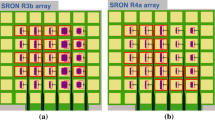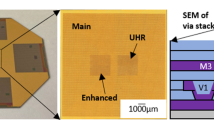Abstract
We are developing kilopixel arrays of TES microcalorimeters to enable high-resolution x-ray imaging spectrometers for future x-ray observatories and laboratory astrophysics experiments. Our current array design was targeted as a prototype for the X-ray Microcalorimeter Spectrometer proposed for the International X-ray Observatory, which calls for a 40×40-pixel core array of 300 μm devices with 2.5 eV energy resolution (at 6 keV). Here we present device characterization of our 32×32 arrays, including x-ray spectral performance of individual pixels within the array. We present our results in light of the understanding that our Mo/Au TESs act as weak superconducting links, causing the TES critical current (I c ) and transition shape to oscillate with applied magnetic field (B). We show I c (B) measurements and discuss the uniformity of these measurements across the array, as well as implications regarding the uniformity of device noise and response. In addition, we are working to reduce pixel-to-pixel electrical and thermal crosstalk; we present recent test results from an array that has microstrip wiring and an angle-evaporated copper backside heatsinking layer, which provides copper coverage on the four sidewalls of the silicon wells beneath each pixel.




Similar content being viewed by others
Notes
Bandler et al. [4] provide a useful schematic of a similar array architecture.
In this paper we address the conditions that are important to allow uniform simultaneous performance. Another important aspect we must address, but which is beyond the scope of this paper, is experimental verification of the magnetic-field stability that is required for good spectral performance. Future work will address this area in detail, and our studies to-date are presented in [9].
Our fitting procedure assumes an equal spectral illumination at each count rate. However, the spectral composition changes slightly for each dataset because the attenuator we employ to reduce the count rate has a slightly energy dependent stopping power. The average incident energy is higher at low count rates, because the ratio of Mn Kβ to Mn Kα x-rays increases at the detector as the total attenuation increases (e.g., at 30 ct/s/pixel the ratio is ≈0.11, whereas at 1 ct/s/pixel it is ≈0.24). However, this shift in spectral composition provides only a small correction term and does not significantly change the fitting results.
References
R.L. Kelley et al., The X-Ray microcalorimeter spectrometer for the international X-ray observatory, in American Institute of Physics Conference Series, ed. by B. Young, B. Cabrera, A. Miller. American Institute of Physics Conference Series, vol. 1185 (2009), pp. 757–760
J.W. den Herder et al., The x-ray microcalorimeter spectrometer onboard of IXO, in Society of Photo-Optical Instrumentation Engineers (SPIE) Conference Series, vol. 7732 (SPIE Press, Bellingham, 2010)
http://ixo.gsfc.nasa.gov/ (2011)
S.R. Bandler, R.P. Brekosky, A.-D. Brown, J.A. Chervenak, E. Figueroa-Feliciano, F.M. Finkbeiner, N. Iyomoto, R.L. Kelley, C.A. Kilbourne, F.S. Porter, J. Sadleir, S.J. Smith, J. Low Temp. Phys. 151, 400–405 (2008)
N. Iyomoto, S.R. Bandler, R.P. Brekosky, A.-D. Brown, J.A. Chervenak, F.M. Finkbeiner, R.L. Kelley, C.A. Kilbourne, F.S. Porter, J.E. Sadleir, S.J. Smith, E. Figueroa-Feliciano, Appl. Phys. Lett. 92, 013508 (2008)
C.A. Kilbourne et al., Proc. SPIE 7011, 701104 (2008)
J.N. Ullom, J.A. Beall, W.B. Doriese, W.D. Duncan, L. Ferreira, G.C. Hilton, K.D. Irwin, C.D. Reintsema, L.R. Vale, Appl. Phys. Lett. 87, 194103 (2005)
J.E. Sadleir, S.J. Smith, S.R. Bandler, J.A. Chervenak, J.R. Clem, Phys. Rev. Lett. 104, 047003 (2010)
S.J. Smith et al., Implications of weak-link behavior on the performance of Mo/Au bilayer transition-edge sensors. J. Appl. Phys. (2011, submitted)
J.A. Chervenak et al., Fabrication of microstripline wiring for large format transition edge sensor arrays. J. Low Temp. Phys. (2012). doi:10.1007/s10909-012-0552-4 (this issue)
N. Iyomoto, S.R. Bandler, R.P. Brekosky, A.-D. Brown, J.A. Chervenak, M.E. Eckart, F.M. Finkbeiner, R.L. Kelley, C.A. Kilbourne, F.S. Porter, J.E. Sadleir, S.J. Smith, IEEE Trans. Appl. Supercond. 19, 557–560 (2009)
M.O. Krause, J.H. Oliver, J. Phys. Chem. Ref. Data 8, 329–338 (1979)
D.W. Fischer, W.L. Baun, J. Appl. Phys. 36, 534–537 (1965)
B. Nordfors, Proc. Phys. Soc. A 68, 654–656 (1955)
D.A. Wollman et al., Nucl. Instrum. Methods A 444, 145–150 (2000)
G. Hölzer, M. Fritsch, M. Deutsch, J. Härtwig, E. Förster, Phys. Rev. A 56, 4554–4568 (1997)
G. Hölzer, F.S. Porter, correction and extension to Hölzer et al., 1997, private communication (2004)
S.R. Bandler et al., Magnetically coupled microcalorimeters. J. Low Temp. Phys. (2012). doi:10.1007/s10909-012-0544-4 (this issue)
T. Stevenson et al., Magnetic penetration effects in small superconducting devices. J. Low Temp. Phys. (2012, this issue)
Acknowledgements
We thank K.D. Irwin and the Quantum Sensors Group (NIST, Boulder) for providing the SQUIDs used in this work. This research was supported in part by appointments to the NASA Postdoctoral Program (CNB, SEB), administered by ORAU.
Author information
Authors and Affiliations
Corresponding author
Rights and permissions
About this article
Cite this article
Eckart, M.E., Adams, J.S., Bailey, C.N. et al. Kilopixel X-ray Microcalorimeter Arrays for Astrophysics: Device Performance and Uniformity. J Low Temp Phys 167, 732–740 (2012). https://doi.org/10.1007/s10909-012-0514-x
Received:
Accepted:
Published:
Issue Date:
DOI: https://doi.org/10.1007/s10909-012-0514-x




